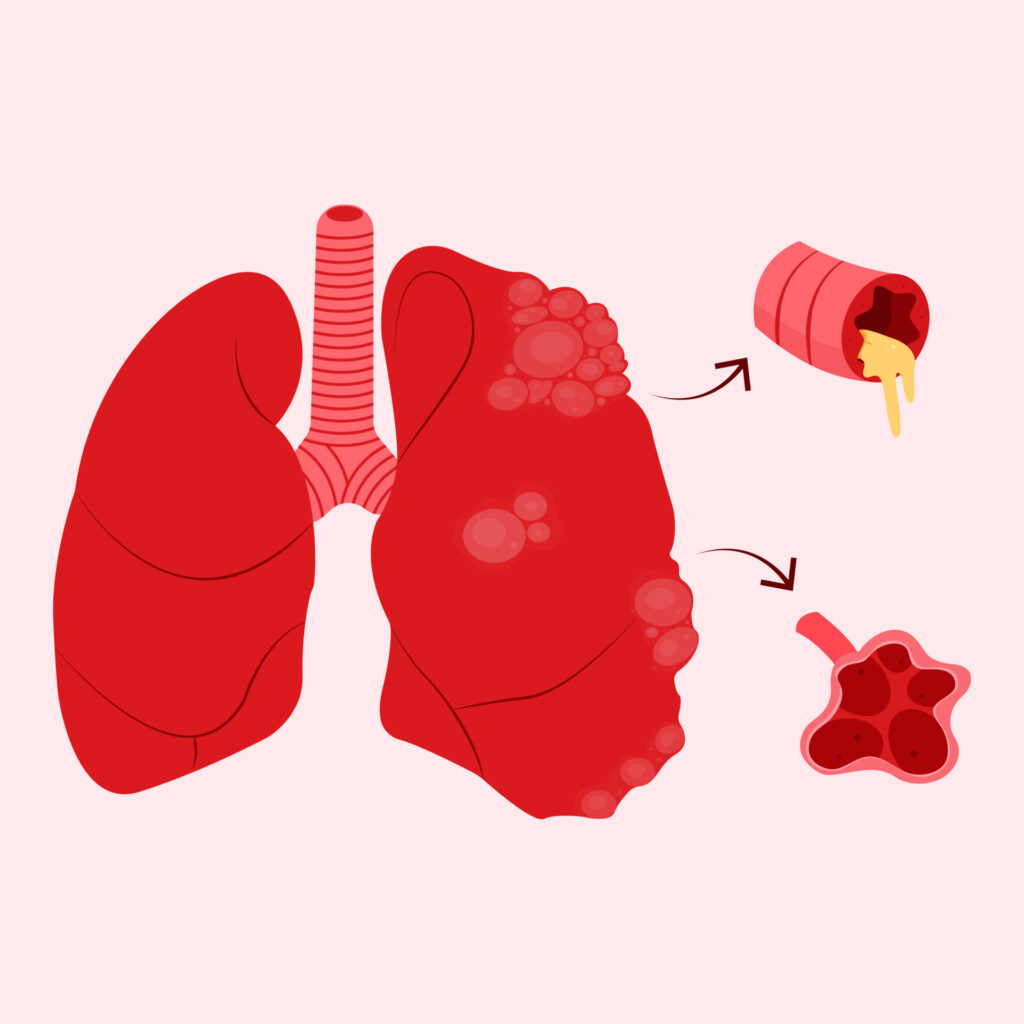What is emphysema?
Emphysema is a progressive respiratory condition characterized by the deterioration of the small air sacs in the lungs known as alveoli. As these sacs become damaged, they lose their elasticity and eventually rupture, merging into a single enlarged air sac. Consequently, the trapped air hinders normal breathing, leading to breathing difficulties for individuals affected by this condition The main factor contributing to the development of emphysema is smoking, although it can also be triggered by exposure to air pollution and recurrent respiratory infections.
Pink Puffer In COPD
Emphysema falls under the category of COPD, which stands for chronic obstructive pulmonary bronchitis is another prevalent form of COPD. At the same time, many individuals with COPD experience both emphysema and chronic bronchitis, the severity of each type varies from one person to another person.
Pink Puffer COPD is a distinct form of COPD that primarily involves emphysema, the term “pink puffer” is derived from the observation that these individuals often have a pink or red complexion. Additionally, they tend to breathe rapidly and deeply to obtain sufficient air into their lungs. Unlike blue bloaters, pink puffers typically do not experience a persistent cough or excessive sputum production.
What Is the Cause of Emphysema?

Pink puffer COPD is a result of emphysema, a chronic respiratory condition that results in the deterioration of the air sacs within the lungs. This deterioration significantly impairs lung function, posing breathing challenges for individuals affected by pink puffer COPD. Emphysema is typically caused by prolonged exposure to irritants that harm the lungs and airways. In the United States, cigarette smoke is the primary culprit, although pipe, cigar, and other forms of tobacco smoke can also lead to emphysema, particularly if inhaled. Other inhaled irritants such as second-hand smoke, air pollution, and chemical fumes or dust from the environment or workplace can also contribute to the development of emphysema. In rare cases, a genetic disorder known as alpha-1 antitrypsin deficiency may be a factor in causing emphysema.
Risk Factors for Emphysema
The individuals who are at risk for emphysema are those who possess certain risk factors. The primary risk factor is smoking, as approximately 75% of individuals with emphysema either smoke or have a history of smoking. Additionally, long-term exposure to other lung irritants such as second-hand smoke, air pollution, chemical fumes, and dust from the environment or workplace can increase the risk. Age also plays a role, as most people who develop emphysema experience symptoms after the age of 40. Furthermore, genetics can contribute to the risk, particularly in cases of alpha-1 antitrypsin deficiency, a genetic condition. Smokers who have a family history of chronic obstructive pulmonary disease (COPD) are also more susceptible to developing emphysema.
Symptoms For Emphysema?
Initially, individuals may not experience any symptoms or only have mild symptoms. However, as the disease progresses, the symptoms typically become more severe. These symptoms may include.
1. Frequent coughing or wheezing
2. A persistent cough that produces a significant amount of mucus
3. Shortness of breath, particularly during physical activity
4. A whistling or squeaky sound when breathing
5. Tightness in the chest
6. Some individuals with emphysema may also experience frequent respiratory infections such as colds and the flu.
7. In severe cases, emphysema can lead to weight loss, weakness in the lower muscles, and swelling in the ankles, feet, or legs.
Pathophysiology
Emphysema is a chronic lung disease characterized by the destruction of the alveoli, which are the tiny air sacs in the lungs responsible for oxygen exchange. This condition is primarily caused by long-term exposure to irritants, such as cigarette smoke or air pollution. As a result of this exposure, the walls of the alveoli become weak and lose their elasticity, leading to the collapse of these air sacs. This collapse reduces the surface area available for oxygen exchange, making breathing difficult for individuals with emphysema. Additionally, the destruction of the alveoli causes air to become trapped in the lungs, leading to hyperinflation. This hyperinflation further impairs lung function and can result in symptoms such as shortness of breath, coughing, and wheezing. Ultimately, emphysema can significantly impact a person’s quality of life and may require medical interventions to manage symptoms and slow down the progression of the disease.
Structure of Lungs
The lungs consist of sponge-like structures located in the chest and are shielded by the ribcage. These structures are composed of air passages that branch out progressively. The main air passage is the windpipe (trachea), which splits into two bronchi, further dividing into smaller bronchioles.
At the end of the bronchioles are tiny air sacs called alveoli, where oxygen from inhaled air is exchanged with carbon dioxide from the blood, which is then exhaled. This vital exchange of gases occurs through a network of capillaries.
The Complications for Emphysema?
Emphysema can lead to various complications such as pneumonia, collapsed lung, and heart problems. People with emphysema are at a higher risk of developing pneumonia due to infection in the alveoli and bronchioles. Additionally, some individuals may experience a collapsed lung when air pockets in the lungs burst, causing lung deflation. Moreover, damaged alveoli, reduced capillaries, and lower oxygen levels in the blood can result in heart problems as the heart needs to work harder to pump blood through the lungs, putting strain on the heart over time.
EMPHYSEMA DIAGNOSIS?
Chronic obstructive pulmonary disease, which includes emphysema, is typically diagnosed through a lung function test known as spirometry. Additional tests that can aid in the diagnosis of emphysema may involve other lung function assessments, chest X-rays, and CT scans.
PHARMACOLOGICAL TREATMENT FOR EMPHYSEMA
Medications, like bronchodilators, are used to relax the muscles surrounding the airways, aiding in the opening of the airways and facilitating easier breathing.
Bronchodilators are commonly administered through an inhaler. In more severe cases, the inhaler may also contain steroids to decrease inflammation. Vaccinations for the flu and pneumococcal pneumonia are recommended for individuals with emphysema, as they are at a higher risk for serious complications from these illnesses.
Antibiotics are prescribed in cases of bacterial or viral lung infections.
Oxygen therapy is utilized for individuals with severe emphysema and low oxygen levels in the blood to improve breathing.
Pulmonary rehabilitation programs, which include exercise routines, disease management education, nutritional guidance, and psychological support, are beneficial for those with chronic breathing issues.
Surgery is considered a last resort for individuals with severe symptoms that have not improved with medications. Surgical options may involve the removal of damaged lung tissue, large air spaces (bullae), or even a lung transplant in extreme cases of severe emphysema. Individuals with emphysema must be aware of when and where to seek assistance for their symptoms.
Emergency care should be sought if experiencing severe symptoms like difficulty breathing or speaking. Contacting a healthcare provider is necessary if symptoms worsen or if signs of infection, such as a fever, are present.
NONPHARMACOLOGICAL TREATMENT
Emphysema, unfortunately, does not have a cure, but it can be managed effectively. By implementing appropriate measures, you can alleviate symptoms, enhance your quality of life, and minimize the need for hospitalization.
The management of emphysema involves several key steps. Firstly, it is crucial to quit smoking immediately and completely, as this is the most effective treatment for both COPD and emphysema. Additionally, it is important to avoid exposure to other air pollutants that can worsen the condition.
Making certain lifestyle changes is also essential. If you are a smoker, quitting smoking is the most significant step you can take to address emphysema. Furthermore, it is vital to steer clear of secondhand smoke and environments where you may inhale lung irritants.
Consulting your healthcare provider for a personalized eating plan that fulfills your nutritional requirements is advisable. Additionally, inquire about the level of physical activity suitable for you. Engaging in physical exercise can strengthen the respiratory muscles and enhance your overall well-being.
HOW TO PREVENT EMPHYSEMA? Prevention of emphysema is possible by refraining from smoking, as smoking is the leading cause of this condition. Additionally, it is crucial to minimize exposure to lung irritants like second-hand smoke, air pollution, chemical fumes, and dust particles.





